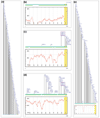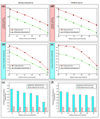Identification of conserved regulatory elements by comparative genome analysis
- PMID: 12760745
- PMCID: PMC193685
- DOI: 10.1186/1475-4924-2-13
Identification of conserved regulatory elements by comparative genome analysis
Abstract
Background: For genes that have been successfully delineated within the human genome sequence, most regulatory sequences remain to be elucidated. The annotation and interpretation process requires additional data resources and significant improvements in computational methods for the detection of regulatory regions. One approach of growing popularity is based on the preferential conservation of functional sequences over the course of evolution by selective pressure, termed 'phylogenetic footprinting'. Mutations are more likely to be disruptive if they appear in functional sites, resulting in a measurable difference in evolution rates between functional and non-functional genomic segments.
Results: We have devised a flexible suite of methods for the identification and visualization of conserved transcription-factor-binding sites. The system reports those putative transcription-factor-binding sites that are both situated in conserved regions and located as pairs of sites in equivalent positions in alignments between two orthologous sequences. An underlying collection of metazoan transcription-factor-binding profiles was assembled to facilitate the study. This approach results in a significant improvement in the detection of transcription-factor-binding sites because of an increased signal-to-noise ratio, as demonstrated with two sets of promoter sequences. The method is implemented as a graphical web application, ConSite, which is at the disposal of the scientific community at http://www.phylofoot.org/.
Conclusions: Phylogenetic footprinting dramatically improves the predictive selectivity of bioinformatic approaches to the analysis of promoter sequences. ConSite delivers unparalleled performance using a novel database of high-quality binding models for metazoan transcription factors. With a dynamic interface, this bioinformatics tool provides broad access to promoter analysis with phylogenetic footprinting.
Figures



References
Publication types
MeSH terms
Substances
LinkOut - more resources
Full Text Sources
Other Literature Sources

